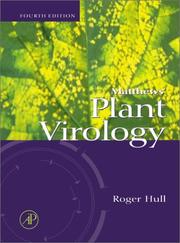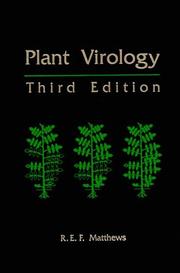| Listing 1 - 10 of 41 | << page >> |
Sort by
|
Book
ISBN: 3540503862 0387503862 3642741665 3642741649 Year: 1990 Volume: vol 41 Publisher: Berlin : Springer-Verlag,
Abstract | Keywords | Export | Availability | Bookmark
 Loading...
Loading...Choose an application
- Reference Manager
- EndNote
- RefWorks (Direct export to RefWorks)
Virus des végétaux --- Plant viruses --- Viroïde --- Viroids --- Virologie --- Virology --- Réponse immunitaire --- Immune response --- Great Britain --- Plant-virus interaction
Book
ISBN: 0128244836 9780128244838 0128216298 9780128216293 Year: 2021 Publisher: London, England : Academic Press,
Abstract | Keywords | Export | Availability | Bookmark
 Loading...
Loading...Choose an application
- Reference Manager
- EndNote
- RefWorks (Direct export to RefWorks)
"Plant Virus-Host Interaction: Molecular Approaches and Viral Evolution, Second Edition, provides comprehensive coverage of molecular approaches for virus-host interaction. The book contains cutting-edge research in plant molecular virology, including pathogenic viroids and transport by insect vectors, interference with transmission to control viruses, synergism with pivotal coverage of RNA silencing, and the counter-defensive strategies used by viruses to overcome the silencing response in plants. This new edition introduces new, emerging proteins involved in host-virus interactions and provides in-depth coverage of plant virus genes' interactions with host, localization and expression. With contributions from leading experts, this is a comprehensive reference for plant virologists, molecular biologists and others interested in characterization of plant viruses and disease management. - Introduces new, emerging proteins involved during the host-virus interaction and new virus strains that invade new crops through recombination, resorting and mutation - Provides molecular approaches for virus-host interaction - Highlights RNA silencing and counter-defensive strategies for disease management - Discusses the socioeconomic implications of viral spread and mitigation techniques."
Virus diseases of plants. --- Plant virus diseases --- Plants --- Plant diseases --- Plant viruses --- Virus diseases --- Virus diseases of plants --- Plant molecular virology --- Host-virus relationships
Dissertation

Year: 2019 Publisher: Liège Université de Liège (ULiège)
Abstract | Keywords | Export | Availability | Bookmark
 Loading...
Loading...Choose an application
- Reference Manager
- EndNote
- RefWorks (Direct export to RefWorks)
Study of plant viruses is essential to address yield loss in crops due to diseases. However, viruses are most often studied in crops while viruses present in wild areas can also have a significant impact if the virus moves from one plot to another according to the different modes of transmission specific to each virus. It is therefore essential to better understand virus behaviour in these non-cultivated areas, and virus adaptation in their environment, through the identification of new virus species, new host plants and study of virus vectors. This will allow to better control disease risks to crops in case of virus transmission to them from wild reservoirs. In this study, prevalence of three plant viruses was examined, i.e. Barley yellow dwarf virus (Luteovirus, Luteoviridae), a new nepovirus (Secoviridae) candidate and a new waikavirus (Secoviridae) candidate three different plant communities (monoculture, pasture and grassland with high ecological value) within the Natural Park of Burdinale Mehaigne (Antheit, Province of Liège, Belgium). Virus prevalence was studied in plant communities as a whole as well as within some specific Poaceae species (Poa trivialis L. and Lolium perenne L.). Virus prevalence was studied using RT-PCR techniques to determine the presence of the virus in plant samples randomly collected from the plots. Co-infections between these three virus species were also analyzed. Bioinformatics analyses were also carried out on nepovirus and waikavirus candidates in order to determine if they represent some new virus species. Results showed a high prevalence (80-90%) of nepoviruses in wild plant communities, while any symptoms were observed. Bioinformatics analyses allowed study phylogeny of different consensus viral sequences established for each plant community. These sequences were then compared with each other but also with reference sequences from NCBI for Nepovirus, Waikavirus and Sequivirus genera (all belonging to Secoviridae family). Bioinformatics study showed that nepovirus is potentially a new virus species similar to Tomato black ring virus and Beet ringspot virus. The waikavirus shows a significant genetic difference with other waikaviruses. A last part of the project was to investigate host range of White clover mosaic virus. This virus, known to only infect Fabaceae plants such as clovers (Trifolium repens L.), was also detected by high throughput sequencing in Lolium perenne L. in a pasture in Héron (Province of Liège). Virus detection by RT-PCR in clovers and ryegrass confirmed sequencing data and allowed to extend host range of this virus species to Poaceae. L'étude des virus des plantes est essentielle pour remédier aux pertes de rendement des cultures dues aux maladies. Cependant, les virus sont le plus souvent étudiés dans les cultures alors que les virus présents dans les zones sauvages peuvent également avoir un impact significatif si le virus se déplace d'une parcelle à une autre selon les différents modes de transmission propres à chaque virus. Il est donc essentiel de mieux comprendre le comportement viral dans ces zones non cultivées et l'adaptation des virus dans leur environnement, par l'identification de nouvelles espèces virales, de nouvelles plantes hôtes et l'étude des vecteurs de virus. Cela permettra de mieux contrôler les risques de maladies pour les cultures en cas de transmission du virus à partir de réservoirs sauvages. Dans cette étude, la prévalence de trois virus végétaux a été examinée, à savoir le Barley yellow dwarf virus (Luteovirus, Luteoviridae), un nouveau nepovirus (Secoviridae) candidat et un nouveau waikavirus (Secoviridae) candidat dans trois communautés végétales différentes (monoculture, pâturage et prairie à haute valeur écologique) dans le Parc naturel Burdinale Mehaigne (Antheit, Province de Liège, Belgique). La prévalence du virus a été étudiée dans l'ensemble des communautés végétales ainsi que dans certaines espèces spécifiques de Poaceae (Poa trivialis L. et Lolium perenne L.). La prévalence du virus a été étudiée à l'aide de techniques de RT-PCR pour déterminer la présence du virus dans des échantillons de plantes prélevés au hasard sur les placettes. Les co-infections entre ces trois espèces de virus ont également été analysées. Des analyses bio-informatiques ont également été effectuées sur des candidats nepovirus et waikavirus afin de déterminer s'ils représentent de nouvelles espèces virales. Les résultats ont montré une prévalence élevée (80-90%) de nepovirus dans les communautés végétales sauvages, alors que des symptômes ont été observés. Les analyses bio-informatiques ont permis d'étudier la phylogénie de différentes séquences virales consensuelles établies pour chaque communauté végétale. Ces séquences ont ensuite été comparées entre elles, mais aussi avec des séquences de référence provenant de NCBI pour les genres Nepovirus, Waikavirus et Sequivirus (tous appartenant à la famille des Secoviridae). Une étude bio-informatique a montré que le nepovirus est potentiellement une nouvelle espèce de virus similaire au Tomato black ring virus et au Beet ringspot virus. Le waikavirus présente une différence génétique significative avec les autres waikavirus. Une dernière partie du projet consistait à étudier la gamme d'hôtes du White clover mosaic virus. Ce virus, connu pour n'infecter que des plantes de Fabaceae telles que le trèfle (Trifolium repens L.), a également été détecté par séquençage à haut débit sur Lolium perenne L. dans un pâturage à Héron (Province de Liège). La détection du virus par RT-PCR sur trèfle et ray-grass a confirmé les données de séquençage et a permis d'étendre la gamme d'hôtes de cette espèce de virus aux Poaceae.

ISBN: 0120342316 9786611735746 1281735744 0080582044 9780080582047 9780120342310 Year: 1977 Publisher: New York ; London : Academic Press,
Abstract | Keywords | Export | Availability | Bookmark
 Loading...
Loading...Choose an application
- Reference Manager
- EndNote
- RefWorks (Direct export to RefWorks)
ADVANCES IN PROTEIN CHEMISTRY VOL 31
Proteins --- Tobacco mosaic virus. --- Pepper mosaic virus --- TMV (Plant virus) --- Tobacco calico virus --- Tobacco distorting mosaic virus --- Tobacco mosaic tobamovirus --- Tomato mosaic virus --- ToMV (Plant virus) --- Mosaic viruses --- Tobamoviruses --- Denaturation of proteins --- Protein denaturation --- Protein unfolding --- Unfolding of proteins --- Coagulation --- Denaturation. --- Unfolding
Book
ISBN: 1281735647 9786611735647 0080581919 0120342189 9780080581910 Year: 1963 Publisher: New York ; London : Academic Press,
Abstract | Keywords | Export | Availability | Bookmark
 Loading...
Loading...Choose an application
- Reference Manager
- EndNote
- RefWorks (Direct export to RefWorks)
ADVANCES IN PROTEIN CHEMISTRY VOL 18
Proteins --- Tobacco mosaic virus. --- Denaturation. --- Pepper mosaic virus --- TMV (Plant virus) --- Tobacco calico virus --- Tobacco distorting mosaic virus --- Tobacco mosaic tobamovirus --- Tomato mosaic virus --- ToMV (Plant virus) --- Mosaic viruses --- Tobamoviruses --- Denaturation of proteins --- Protein denaturation --- Protein unfolding --- Unfolding of proteins --- Coagulation --- Unfolding

ISBN: 0123611601 9786611033033 0080535992 1281033030 143560802X 9780080535999 9780123611604 9781281033031 6611033033 9781435608023 Year: 2002 Publisher: San Diego Academic Press
Abstract | Keywords | Export | Availability | Bookmark
 Loading...
Loading...Choose an application
- Reference Manager
- EndNote
- RefWorks (Direct export to RefWorks)
It has been ten years since the publication of the third edition of this seminal text on plant virology, during which there has been an explosion of conceptual and factual advances. The fourth edition updates and revises many details of the previous edition, while retaining the important older results that constitute the field's conceptual foundation.Key features of the fourth edition include:* Thumbnail sketches of each genera and family groups* Genome maps of all genera for which they are known* Genetic engineered resistance strategies for virus disease control* Latest
Plant viruses --- Control --- Plant viruses. --- Virus diseases of plants. --- Control. --- Phytopathogenic viruses --- Plant virology --- Phytopathogenic microorganisms --- Viruses --- Virus diseases of plants --- Plant virus diseases --- Plants --- Plant diseases --- Virus diseases --- Fitopatología (25153311) --- Bibliografía recomendada --- Plant viruses - Control
Book
ISBN: 9782453250 Year: 1988 Publisher: Lagos OAU/STRC
Abstract | Keywords | Export | Availability | Bookmark
 Loading...
Loading...Choose an application
- Reference Manager
- EndNote
- RefWorks (Direct export to RefWorks)
Virus des végétaux --- Plant viruses --- Virose --- Viroses --- Theobroma cacao --- Légumineuse --- Legumes --- Helianthus annuus --- Arachis hypogaea --- Ipomoea batatas --- Contrôle de maladies --- Disease control --- Manihot esculenta --- Afrique --- Africa --- Virus diseases of plants --- Plant virus diseases --- Plants --- Plant diseases --- Congresses --- Virus diseases --- Cta
Book
Year: 2021 Publisher: Basel, Switzerland MDPI - Multidisciplinary Digital Publishing Institute
Abstract | Keywords | Export | Availability | Bookmark
 Loading...
Loading...Choose an application
- Reference Manager
- EndNote
- RefWorks (Direct export to RefWorks)
Plant viruses cause many of the most important diseases threatening crops worldwide. Over the last quarter of a century, an increasing number of plant viruses have emerged in various parts of the world, especially in the tropics and subtropics. As is generally observed for plant viruses, most of the emerging viruses are transmitted horizontally by biological vectors, mainly insects. Reverse genetics using infectious clones—available for many plant viruses—has been used for identification of viral determinants involved in virus–host and virus–vector interactions. Although many studies have identified a number of factors involved in disease development and transmission, the precise mechanisms are unknown for most of the virus–plant–vector combinations. In most cases, the diverse outcomes resulting from virus–virus interactions are poorly understood. Although significant advances have been made towards understand the mechanisms involved in plant resistance to viruses, we are far from being able to apply this knowledge to protect cultivated plants from the all viral threats.The aim of this Special Issue was to provide a platform for researchers interested in plant virology to share their recent results. To achieve this, we invited the plant virology community to submit research articles, short communications and reviews related to the various aspects of plant virology: ecology, virus–plant host interactions, virus–vector interactions, virus–virus interactions, and control strategies. This issue contains some of the best current research in plant virology.
whitefly --- begomovirus --- Vta1 --- virus transmission --- coat proteins --- membrane association --- topology --- cilevirus --- movement protein --- p29 capsid protein --- barley yellow dwarf virus --- BYDV --- wheat --- barley --- yield loss --- vectors --- aphids --- persistent virus --- Amalgaviridae --- synergism --- antagonism --- vsiRNAs --- miRNAs --- mixed-infections --- Arabidopsis thaliana --- Cucumber mosaic virus --- genome-wide association studies --- plant–virus interaction --- seed transmission --- virulence --- callose --- coat protein --- plasmodesmata --- triple gene block --- viral suppressor --- virus movement --- virus replication complex --- TYLCD --- TYLCV --- tomato --- Solanum lycopersicum --- disease resistance --- plant breeding --- PAMP-triggered immunity --- effector-triggered immunity --- RNA silencing --- viral suppressors --- NIK1 --- PTI --- ETI --- geminiviruses --- host jumping --- viral evolution --- trade-off --- plant virus --- RNA virus --- potyvirus --- Plum pox virus --- VPg --- eIF4E --- high-throughput sequencing --- bioinformatics --- detection --- discovery --- MinION --- nanopore sequencing --- rolling circle amplification --- viral metagenomics --- CRESS DNA --- capulavirus --- homopolymer --- Begomovirus --- cucumber --- mechanical inoculation --- real-time PCR --- viral load --- QTLs --- resistance --- Geminiviridae --- sweepoviruses --- DNA satellites --- Deltasatellite --- helper virus range --- transreplication --- high-throughput sequencing (HTS) --- virus --- dsRNA --- total RNA --- OLV1 --- LRNV --- ToFBV --- ASGV --- host adaptation --- virus evolution --- n/a --- plant-virus interaction
Book
ISBN: 0521331056 Year: 1987 Volume: 40 Publisher: Cambridge London New York Cambridge University Press
Abstract | Keywords | Export | Availability | Bookmark
 Loading...
Loading...Choose an application
- Reference Manager
- EndNote
- RefWorks (Direct export to RefWorks)
Virus diseases --- Pathology, Molecular --- Virus diseases of plants --- Pathologie moléculaire --- Congresses --- Congrès --- Virus Diseases --- -Virus diseases --- -Virus diseases of plants --- -Plant virus diseases --- Plants --- Plant diseases --- Plant viruses --- Viral diseases --- Viral infections --- Virus infections --- Communicable diseases --- Medical virology --- Pathogenic viruses --- Molecular pathology --- Molecular biology --- Physiology, Pathological --- microbiology. --- Congresses. --- microbiology --- congresses. --- -microbiology. --- Pathologie moléculaire --- Congrès --- Microbiology

ISBN: 0124805531 0323138489 129944248X Year: 1991 Publisher: San Diego (Calif.): Academic press
Abstract | Keywords | Export | Availability | Bookmark
 Loading...
Loading...Choose an application
- Reference Manager
- EndNote
- RefWorks (Direct export to RefWorks)
Plant viruses --- Plant viruses. --- Virus diseases of plants. --- Control. --- Virology --- Molecular biology --- Molecular genetics --- genomes --- Maladies à virus des plantes --- Planten--Virussen --- Plantes--Virus --- Virus des plantes --- Virus diseases of plants --- Virussen van planten --- Virusziekten bij planten --- -Virus diseases of plants --- Plant virus diseases --- Plants --- Plant diseases --- Phytopathogenic viruses --- Plant virology --- Phytopathogenic microorganisms --- Viruses --- Control --- Virus diseases --- Plant viruses - Control. --- Virus, plant
| Listing 1 - 10 of 41 | << page >> |
Sort by
|

 Search
Search Feedback
Feedback About UniCat
About UniCat  Help
Help News
News